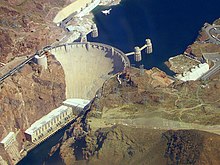
Back سياسة الطاقة في الولايات المتحدة Arabic Política energética de los Estados Unidos Spanish Yhdysvaltain energiapolitiikka Finnish นโยบายพลังงานแห่งสหรัฐอเมริกา Thai


This article has multiple issues. Please help improve it or discuss these issues on the talk page. (Learn how and when to remove these messages)
|
The energy policy of the United States is determined by federal, state, and local entities. It addresses issues of energy production, distribution, consumption, and modes of use, such as building codes, mileage standards, and commuting policies. Energy policy may be addressed via legislation, regulation, court decisions, public participation, and other techniques.
Federal energy policy acts were passed in 1974, 1992, 2005, 2007, 2008, 2009,[1] 2020, 2021, and 2022, although energy-related policies have appeared in many other bills. State and local energy policies typically relate to efficiency standards and/or transportation.[2]
Federal energy policies since the 1973 oil crisis have been criticized for having an alleged crisis-mentality, promoting expensive quick fixes and single-shot solutions that ignore market and technology realities.[3][4]
Americans constitute less than 5% of the world's population but consume 26% of the world's energy[5] to produce 26% of the world's industrial output. Technologies such as fracking and horizontal drilling allowed the United States to become the world's top oil fossil fuel producer in 2014.[6] In 2018, US exports of coal, natural gas, crude oil and petroleum products exceeded imports, achieving a degree of energy independence for the first time in decades.[7][8][9] In the second half of 2019, the US was the world's top producer of oil and gas.[10] This energy surplus ended in 2020.[11][12]
Various multinational groups have attempted to establish goals and timetables for energy and other climate-related policies, such as the 1997 Kyoto Protocol and the 2015 Paris Agreement.
- ^ "Energy Independence and Security Act of 2007 (Enrolled as Agreed to or Passed by Both House and Senate)". Archived from the original on January 15, 2016. Retrieved 2008-01-18.
- ^ "Database of State Incentives for Renewables & Efficiency". Dsireusa.org. Retrieved March 30, 2012.
- ^ Grossman, Peter (2013). U.S. Energy Policy and the Pursuit of Failure. Cambridge University Press. p. 416. ISBN 978-1107005174.
- ^ Hamilton, Michael S. 2013. Energy Policy Analysis: A Conceptual Framework. Armonk, NY: M.E. Sharpe, Inc.
- ^ "SEI: Energy Consumption". Solarenergy.org. Archived from the original on May 25, 2009. Retrieved March 30, 2012.
- ^ Smith, Grant (July 4, 2014). "U.S. is now world's biggest oil producer". www.chicagotribune.com. Bloomberg News. Retrieved July 4, 2014.
- ^ "EIA: U.S. Net Oil Imports to Drop to Lowest Levels in 60 Years". Retrieved July 13, 2018.
- ^ "BP Statistical Review 2018" (PDF). Retrieved June 15, 2018.
- ^ "U.S. Will Soon Export More Oil, Liquids Than Saudi Arabia". Retrieved March 9, 2019.
- ^ "U.S. Is Now Largest Oil... And Gas Producer In The World". Retrieved August 24, 2019.
- ^ "Is U.S. Energy Dominance Coming To An End?". Retrieved April 8, 2020.
- ^ "Oil producers agree to cut production by a tenth". BBC News. April 9, 2020. Retrieved April 10, 2020.